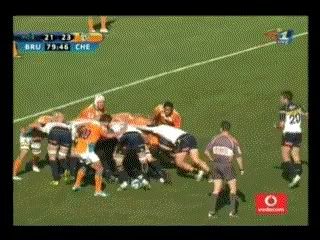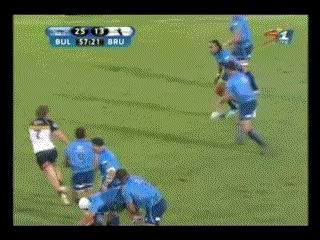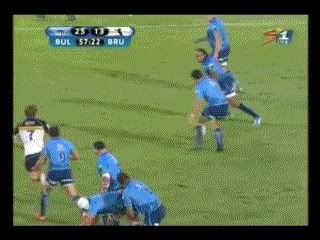C
Cave Dweller
Guest
Here is another one. Try or no try. But look at it from a neutral point of view so forget who the two teams is just make a call according your opinion.
Try or not?
Try or not?
Ok Bris. But the referee was wrong. Mr Bray also came out and said that the referee made a mistake there. Forget about the scrumming inwards or anything like that. Look at the scrum. Are the binding correct, no slingslot, no hands on the ground. All that scrum do is wheel. Thats it a simple wheel.
Lets look at the law
See no different interpretation just 1 possible simple.
Ref did wrong Cheetahs - Bray
2012-03-13 17:41
Brenden Nel - SuperSport
Johannesburg - SANZAR referees boss Lyndon Bray has admitted there was a “big imbalance” in the way referee Keith Brown allowed the Brumbies an advantage in hitting in at the scrums in their match on Saturday.
Bray has also called for more clarity on the final penalty, the one which gifted the Brumbies a victory on the whistle after being behind for most of the match.
It is clear that SANZAR is not happy with Brown’s calls in the game, especially in the setpiece, where the Cheetahs were penalised five times, often within striking distance, and saw the Brumbies claw their way back from 23-10 to win the game.
While there is nothing that can be done about the result, talk within refereeing circles is that Brown is on shaky ground and will need to up his game or fall off the SANZAR refereeing panel.
Bray, in Cape Town to meet with SARU officials and with teams in the country, said that Brown would still undergo the official SANZAR review, but had already done a “self-review” where the imbalance was apparent.
“Keith has done his own self-review and out of it the scrums to me stood out as the big imbalance. Taking out the debate about the last penalty, the imbalance came with the way he managed the engage sequence in the scrum setpieces,” Bray told SuperSport.com
“There was no question that the Cheetahs did go early, but both packs did and that started earlier with the Brumbies going early on the engage call, to which the Cheetahs responded. There were consequences to that, in that the hip position got messy and the Cheetahs lost confidence in the engage process. Keith has to take ownership of that in the game.”
As for the final penalty, where the Cheetahs were penalised for wheeling the scrum, but have subsequently claimed it was the Brumbies and not them who wheeled the setpiece, Bray is waiting for clarity from the three country scrum experts before making a call.
The Cheetahs afterwards said they ordered players not to wheel the scrum in case there was to be a penalty, but were penalised anyway.
“I’ve sent an email to the three scrum coaches in the countries and am waiting for a response,” Bray explained.
“The issue is that about three years ago we had what we call a “sideways crib”, where the back five literally walk sideways in the scrum. At the time we all agreed that it was rubbish and a negative tactic that was not in the spirit of the contest at the scrum.
“We spent a lot of time at the time debating how do you rule on it. The coaches felt at the time that you need to allow players to have an effective forward push before a scrum can wheel. If there is that, then if the scrum goes around the corner, and the scrum literally turns on its access, it isn’t illegal, as long as there is a forward shove.”
“What I’ve asked is these three or four decisions which led to penalties and the last one to have a professional view as to how we approach this. We need to get back to all the referees and make sure they are mindful that this must be done legally.”
You are not allowed to deliberately wheel the scrum by having one side of the scrum pushing and the otherside pulling or not pushing at all. The whole scrum should be pushing forward. Then if you have a dominant tighthead prop or loosehead prop, this will result in the scrum being wheeled through 90 degress. Wheeling through 90 degrees should not be achieved through one side pushing and the other side not.
Mr Bray did not come out and say that the referee made a mistake on that particular scrum. He came out and said that throughout the whole match, the referee had not policed the early engagement properly. He said that this was initiated by the Brumbies (who weren't penalised), but when the Cheetahs responded, they were penalised on multiple occasions. It had nothing to do with the last scrum.
See.it isn’t illegal, as long as there is a forward shove.”
Read Bray's comments above. I'm not interested in spending hours reading the lawbook. I have seen that type of action penalised hundreds of times.What law state you are not allowed to wheel the scrum or states anything that say a wheeling scrum is sanctioned by a penalty?
Here's the link to the law book if you do not have it.
www.irblaws.com/downloads/EN/IRB_Laws_2012_EN.pdf
Exactly, there has to be a forward shove. The referee suggested that the back 5 of the Cheetahs did not push forward, but rather that they pushed sideways.See.
Can anybody comment on this. What is your opinion. Correct or was it the wrong decision? Do not worry about the teams that were involved nor who has gotten the short end out of it but just look if you see a infringement and if so what was it.
Here is another one. Try or no try. But look at it from a neutral point of view so forget who the two teams is just make a call according your opinion.
Try or not?
Brays comments are not the laws. Refs do not go on the field and apply Brays comments. They apply the IRB's Law of Rugby Union. Show me where in The Official laws the referee apply to every match it states a wheeling scrum is sanctioned by a penalty. Brays comments has to do with other techniques which is illegal. He says forward shove but he really means the loosehead walks around the tighthead, the tighthead will have to break his bind and bring his arm to his chest to protect his ribs. They call it sheering off. But that did not happen. The scrum wheeled and the bind by the front rowers was legal. He penalised them for a wheeling scrum not for sheering or breaking the bind. I posted the law for a wheeling scrum and there is no sanction for a penalty. So it was the wrong decision plain and simple.Read Bray's comments above. I'm not interested in spending hours reading the lawbook. I have seen that type of action penalised hundreds of times.
No. The law is there to protect the players. You do not penalise the effect but the cause. The wheeling scrum was the cause for them to detach. You cannot ignore the wheeling scrum and penalise for breaking the bind when the law clearly statesPenalty to the Ponies: two Cheetahs' backrowers detached before the ball was out. The ref should've gone down the "not bound from wrist to shoulder" path and there'd be no controversy.
(a) If a scrum is wheeled through more than 90 degrees, so that the middle line has passed beyond a position parallel to the touchline, the referee must stop play and order another scrum.
(b) This new scrum is formed at the place where the previous scrum ended. The ball is thrown in by the team not in possession at the time of the stoppage. If neither team win possession, it is thrown in by the team that previously threw it in.
No. The law is there to protect the players. You do not penalise the effect but the cause. The wheeling scrum was the cause for them to detach. You cannot ignore the wheeling scrum and penalise for breaking the bind when the law clearly states
Brays comments are not the laws. Refs do not go on the field and apply Brays comments. They apply the IRB's Law of Rugby Union. Show me where in The Official laws the referee apply to every match it states a wheeling scrum is sanctioned by a penalty. Brays comments has to do with other techniques which is illegal. He says forward shove but he really means the loosehead walks around the tighthead, the tighthead will have to break his bind and bring his arm to his chest to protect his ribs. They call it sheering off. But that did not happen. The scrum wheeled and the bind by the front rowers was legal. He penalised them for a wheeling scrum not for sheering or breaking the bind. I posted the law for a wheeling scrum and there is no sanction for a penalty. So it was the wrong decision plain and simple.
It is impossible to ref every single action and reaction within rugby exactly to the letter of the law. There is room for interpretation for every single written law. With respect to the wheeling of a scrum, if a referee feels that a scrum has rotated through 90 degrees not as the result of both teams pushing forward, he will either a) order a re-set of the scrum, or b) penalise the defensive team who he feels are deliberately wheeling the scrum without pushing forward.
If this was not the case, every team on a defensive scrum would simply walk sideways and allow the scrum to go through 90 degrees and earn themselves a scrum with their feed.
I think we will have to agree to disagree on this one as I do not think you understand the reason why the referee awarded this penalty (whether he was right or wrong).
Thank you.It is impossible to ref every single action and reaction within rugby exactly to the letter of the law.
Good point. But there is nothing in the laws that say standing up is against the laws. Pushing up yes but not standing up. There will never be a law like that either. Why? Because a prop standing up is a mechanism to protect himself from getting injured. It also means its a prop under pressure. But it is not illegal to stand up. A referee will exercise the law book and only the law book when he is on the field. He will miss things. Does he miss it because he is human or he is not neutral?That might be how you see it, CD, but look how early the three Cheetahs back-rowers detach and lift their heads, it was well before the scrum started to wheel.
Different refs look for different things, the Cheetahs back-rowers detaching early was a no-brainer for me.

Ok put yourself in the shoe as the referee. TMO can oly tell you about the grounding. Start looking when he gets tackled. All this is going through a refs mindTMO got it right.
15.5 THE TACKLED PLAYER
(a) A tackled player must not lie on, over, or near the ball to prevent opponents from gaining possession of it, and must try to make the ball available immediately so that play can continue.
Sanction: Penalty kick
(b) A tackled player must immediately pass the ball or release it. That player must also get up or move away from it at once.
Sanction: Penalty kick
(c) A tackled player may release the ball by putting it on the ground in any direction, provided this is done immediately.
Sanction: Penalty kick
(d) A tackled player may release the ball by pushing it along the ground in any direction except forward, provided this is done immediately.
Sanction: Penalty kick
22.1 GROUNDING THE BALL
There are two ways a player can ground the ball:
(a) Player touches the ground with the ball. A player grounds the ball by holding the ball and touching the ground with it, in in-goal. ‘Holding’ means holding in the hand or hands, or in the arm or arms. No downward pressure is required.
(b) Player presses down on the ball. A player grounds the ball when it is on the ground in the
in-goal and the player presses down on it with a hand or hands, arm or arms, or the front of
the player’s body from waist to neck inclusive.
22.3 BALL GROUNDED BY AN ATTACKING PLAYER
(a) Try. When an attacking player who is onside is first to ground the ball in the opponents’ ingoal, the player scores a try. This applies whether an attacking or a defending player is responsible for the ball being in the in-goal.
(c) A tackled player may release the ball by putting it on the ground in any direction, provided this is done immediately.
Sanction: Penalty kick



Here is another one
The Bulls won by 2 points. That try was disallowed. Was the decision correct? The assistant told the ref that Carter obstructed Basson from tackling the ball carrier. Was the assistant correct?
